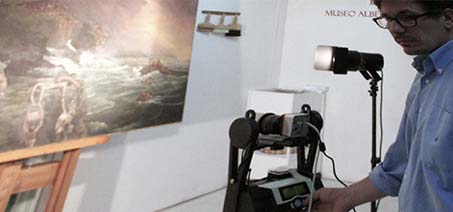
Last September I was giving a 3 weeks training for the Instituto Nacional de Patrimonio Cultural (INPC) of Ecuador, in Quito. They already have a well-equipped analytical lab and needed to set up a multispectral imaging studio. I suggested them the tools to buy and once the parcels where all arrived I went to Quito to set up the lab and training their staff. As for the InGaAs camera, for Panoramic Infrared Reflectography, I recommended a Xenics Bobcat 320. I already posted on the high-end and more expensive Xenics Bobcat 640.

This is actually an exceptionally good InGaAs camera. Though, its cost it’s still very high and I didn’t want the INPC to invest great part of their budget just on the InGaAs camera, even if a remarkable piece of equipment. They were to start from the ground the imaging lab and there are plenty of things an imaging studio can do for art documentation and examination, such as multispectral imaging, 3D modeling, virtual tours, and special photographic methods as reflectance transformation imaging. So, I wanted them to purchase an affordable InGaAs camera from a company whose products and customer care service I had already tested. There are other InGaAs models, more cheap, but the Xenics Bobcat 320 is, for what I know, the best compromise between performance and cost. Let’s dwell now on the actual evaluation of this camera, specifically for Panoramic Infrared Reflectography.
As its name says this camera has a 320×256 pixels sensor and the camera belongs to the category of the affordable InGaAs cameras with the smaller pixels count. The 640×512 pixels cameras have roughly double the price and the 1280 x 1024 pixels, I didn’t even dare to ask for the price. Anyway, the really significant factor, though, about the new line of InGaAs cameras, compared with the old models (as my Merlin Indigo System camera, though, sturdy and reliable) is their smaller pixel pitch which, in simpler worlds, is the dimension of each pixel. The pixel pitch for the Merlin Indigo System camera is 30×30 microns, while for the Xenics Bobcat 320 is 20×20 microns. This means that the overall dimensions of the detector are smaller and consequently the crop factor is higher. I talked about the crop factor in this paper.
Consequently a lens mounted on a Xenics Bobcat 320 provides higher magnification than when mounted on the Merlin Indigo camera.

And this turns particularly useful for Panoramic Infrared Reflectography, since with the same lens we can put the camera further away from the painting to get the same magnification as with the Merlin Indigo System camera. Practical advantages are that we have larger depth of field and less deformation. Bottom line, higher quality Panoramic Infrared Reflectography.

The new InGaAs cameras are smaller because they do not have a thermoelectric cooling system. This means much smaller dimensions but longer time for temperature stabilization. The old Merlin Indigo systems take just 5 minutes, the Bobcat series about 20 minutes. This actually is not at all big issue, you can take the 20 minutes to enjoy looking at the painting using just your eyes. To obtain the best image quality it is advised to keep the temperature of the camera stable.






Hi Antonino.
Thanks for the interesting article.
Looks like you had a good time in Ecuador.
Could you post some examples of the results you got with the Xenics Bobcat 320. I’d like to see the quality.
Also, how many tiles (shots) do you normally need for a good reproduction?
I also noticed that in the video, you are extremely close to the painting. This would cause a fair amount of perspective deformation. No?
Hola Moshe, I’ll send you some material by email. You need to cover with each shot an area of about 6 cm wide to have a good resolution. In the video we were taking a stiched reflectogram of a small portion of the painting, an area if interest.
Hola Antonino
Espero que hayas disfrutado tu viaje a Ecuador
I would like to know about the lens you use at the camera, if you are so close i think is a macro one, do you use adapter ring to mount the lens?
Cuando vuelvas a Latino América podrías venir a Chile a conocer el CNCR
http://www.cncr.cl
Saludos Cordiales
Hola Carolina,
Ecuador was amazing!!! There are different solutions as for lenses. All depend on what your tasks are and your budget is. For the Instituto Nacional de Patrimonio Cultural I suggested a 50mm and a 200 mm Mikon lenses with a c-mount adapter fro the ingaas camera. I’d love to visit CNCR! Hasta luego!